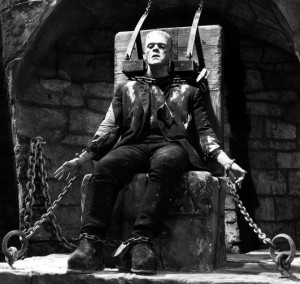 I had already been wowed by the film’s predecessor: the 1931 thriller about a doctor named Frankenstein who assembles a man from the body parts of the dead, using safe, clean, affordable electricity to bring him to life. At first the bolt-necked patchwork creation appears docile — like a frightened stray dog, able to obey simple commands. But soon he’s spooked by the sight of a torch, and all hell breaks loose. Branded a monster, he’s chained to dungeon walls, taunted with fire, hunted down by thick-witted peasants, forced to wear drab, ill-fitting clothes, and denied even the most rudimentary instruction in diction, decorum, and the dangers of tossing one’s playmates into the pond. No wonder he was grumpy.
I had already been wowed by the film’s predecessor: the 1931 thriller about a doctor named Frankenstein who assembles a man from the body parts of the dead, using safe, clean, affordable electricity to bring him to life. At first the bolt-necked patchwork creation appears docile — like a frightened stray dog, able to obey simple commands. But soon he’s spooked by the sight of a torch, and all hell breaks loose. Branded a monster, he’s chained to dungeon walls, taunted with fire, hunted down by thick-witted peasants, forced to wear drab, ill-fitting clothes, and denied even the most rudimentary instruction in diction, decorum, and the dangers of tossing one’s playmates into the pond. No wonder he was grumpy.
Flash forward to the monster’s second feature film. Despite his expanding vocabulary, he’s as lonely and misunderstood as ever. He demands his now-estranged creator build him a friend — better yet, a bride!
Soon, the laboratory is once again abuzz with activity, as Dr. Frankenstein and his mad mentor Dr. Pretorius giddily rev up the machinery. Bones and organs arrive by FedEx. Fashion designers line up at the door, all vying to be the bride’s official dressmaker. Tabloid photographers position their cameras at filthy windows. (Well, that’s how it would play out today, you know.)
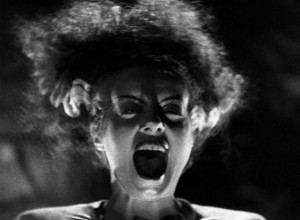 At last the scientists unveil their new creation: a willowy femme fatale in a makeshift Grecian gown, her head design inspired by Nefertiti, her hair embellished with fabulous lightening bolt streaks. I couldn’t take my eyes off her! And neither could the monster, as he descends the stairs to the eerie lab, cautiously optimistic.
At last the scientists unveil their new creation: a willowy femme fatale in a makeshift Grecian gown, her head design inspired by Nefertiti, her hair embellished with fabulous lightening bolt streaks. I couldn’t take my eyes off her! And neither could the monster, as he descends the stairs to the eerie lab, cautiously optimistic.
“Friend?” he pleads tenderly, as he staggers toward her with outstretched hands. In robotic motion, she cranes her cross-stitched neck, swivels her prominent head, fixes her frozen doll-eyes upon him, and lets out a shriek that could wake the…whatever. Undeterred, he follows her across the room to a bench. Smiling timidly, he lifts her thin gauze-wrapped arm and gently pats her long withered fingers. She drops her jaw, screams into his face, and recoils. The monster is devastated. His facial expression dissolves from joy to sadness to rage in the course of 5 seconds. “She hate me…like others,” he grunts, and proceeds to blow up the laboratory, taking the snooty bride and crazy Dr. Pretorius along with him as he returns to the dead. What a grand way to end the worst first date in history. Such unbridled, passionate vengeance! A true existentialist’s delight!
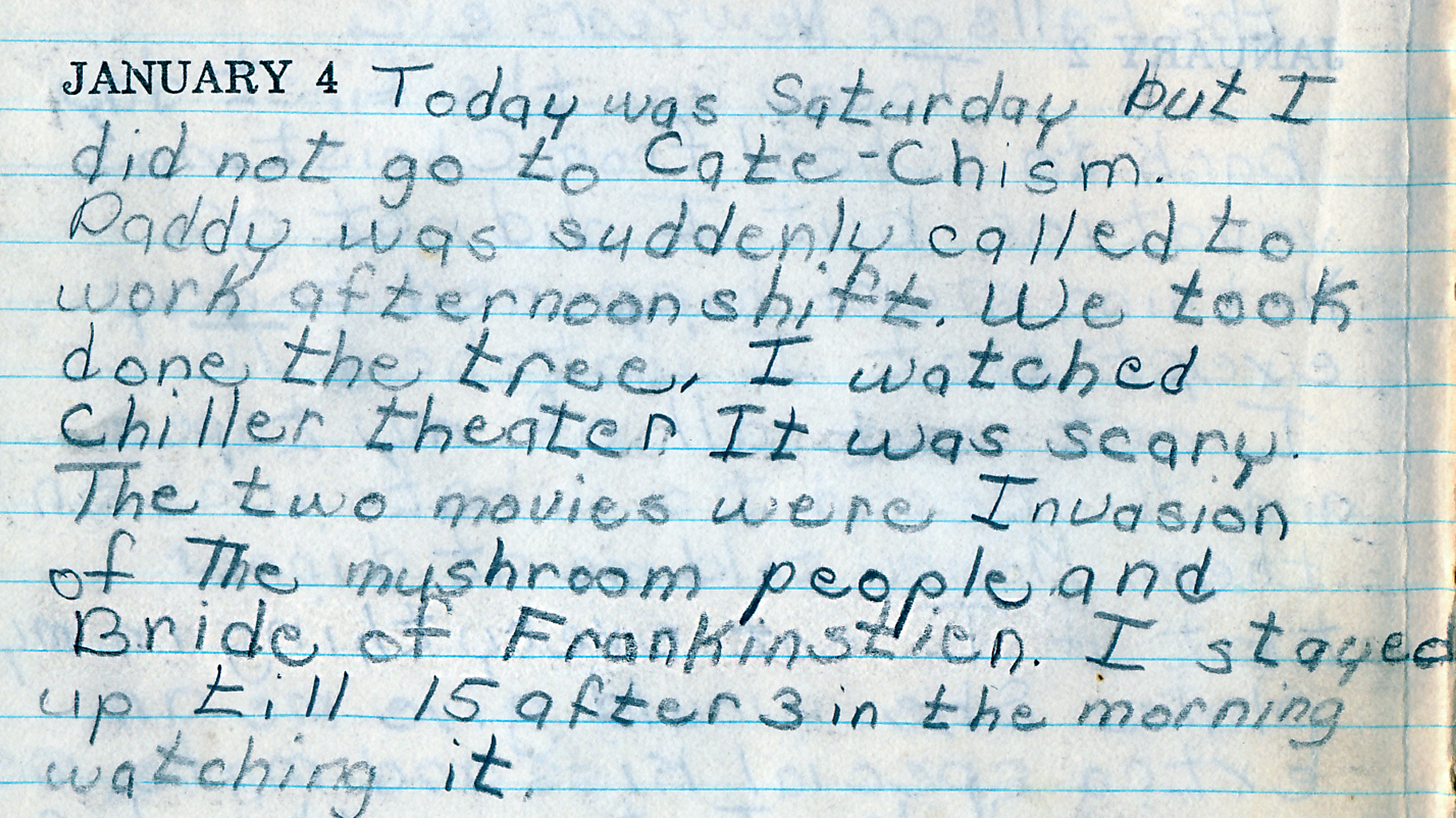 I was terribly moved by this scene. In fact, I was completely verklempt by the entire production, even noting it in my diary, January 4, 1969 (“Chiller Theater” was my midnight catechism). At age 9, already a night owl…an only-child feeling isolated and misunderstood…I strongly identified with the monster’s emotions.
I was terribly moved by this scene. In fact, I was completely verklempt by the entire production, even noting it in my diary, January 4, 1969 (“Chiller Theater” was my midnight catechism). At age 9, already a night owl…an only-child feeling isolated and misunderstood…I strongly identified with the monster’s emotions.
This cinematic masterpiece introduced me to societal rejection, unrequited love, mob mentality, and the tortured soul of the outcast. The monster was to spend his days friendless, sexless, and reviled — simply because no one cared or dared to see past his rough features and undeveloped communication skills.
In fact, this film launched my lifelong love of antihero movies: “Cool Hand Luke,” “Midnight Cowboy,” “Dog Day Afternoon,” “Edward Scissorhands” — all films that end with the sad death or defeat of a misfit, a scapegoat, a would-be contender, a beautiful loser.
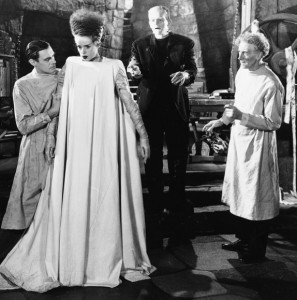 Much has been written about the monster first introduced on the pages of Mary Shelley’s 1818 novel Frankenstein. The creature has been the subject of more than 70 films since 1910. Cinema buffs and sociologists have long analyzed the biblical, homosexual, and megalomaniacal subtexts of many of these movies.
Much has been written about the monster first introduced on the pages of Mary Shelley’s 1818 novel Frankenstein. The creature has been the subject of more than 70 films since 1910. Cinema buffs and sociologists have long analyzed the biblical, homosexual, and megalomaniacal subtexts of many of these movies.
And while the casual viewer might dismiss the 1931 “Frankenstein” and its “Bride” sequel as nothing more than campy entertainment, serious lovers of the art of film all agree that when it comes to the archetypical monster movie, nothing compares to the visual, soul-stirring spectacle of those two magnificent thrillers. (Not to mention the bride’s hairdo, which yer blogger will be dreaming about forever.)
Here’s the famous scene of the monster couple’s first and last date. Both “Frankenstein” and “Bride of Frankenstein” were directed by the great James Whale, Hollywood’s first openly gay director. Boris Karloff (born William Henry Pratt) plays the monster. Elsa Lanchester, as the bride, wore stilts to appear 7 feet tall. Colin Clive, who succumbed to alcoholism at age 37, plays the manic Henry Frankenstein. But the actor who steals the show and adds a dose of comic relief is Ernest Thesinger as Dr. Pretorius. Pay attention to the superb editing (by Ted J. Kent) in the final moments before the teary-eyed monster “blows them all to atoms.” The bride bids farewell with one final hiss. This is one of my favorite movie scenes of all time.
© Dana Spiardi, Nov 1, 2013
]]>
Woulda, coulda, shoulda. That was the story of Gram’s life. He’d have turned 70 today, and might have accomplished a whole lot of things had he not checked out (chemically, permanently) in room #8 of the Joshua Tree Inn on September 19, 1973.
I’ve written a lot about the man and his music through the years. Now, just how many more new aspects of Gram can I force feed you?
Let’s take a look at some of his few existing filmed performances, starting with an all-too-short appearance in “The Trip,” a 1967 counter-culture movie directed by Roger Corman. It includes several scenes that feature Gram performing with one of his early groups, The International Submarine Band. It’s hard to catch Gram in action in this clip, because the scenes are short and the editing is fast. But you can see him in the early scene wearing a striped shirt, standing in the middle of the other band members, way in the background. In the party scene he’s wearing a red jacket, high-neck white shirt and sunglasses. He always stands out in a crowd.
Gram wrote the song “Lazy Days” for this film, but Corman felt it wasn’t psychedelic enough for this acid hippie flick. So he kept the scenes of the band lip-syncing and guitar-syncing and replaced the music with a track by the band Electric Flag (listed in credits as The American Music Band). There’s no credit in the film for Gram or the Sub Band. The movie stars Peter Fonda and Bruce Dern and was written by Jack Nicholson.
Gram gets some real face-time at last, flirting and flaunting for the camera in this 1969 video with The Flying Burrito Brothers, the group he co-founded with Chris Hillman in 1968. “Christine’s Tune” is one of the group’s best and most popular songs. He co-wrote it with Hillman (who shares lead vocals) about Christine Hinton, a one-time girlfriend of David Crosby’s. When Christine was killed in a freak car accident shortly after this song was recorded it became known as “Devil in Disguise.” The boys were all decked out in their famous “Nudie Suits” for this performance. But look closely at Gram’s ensemble, embellished with flames, poppies, multi-colored pills, marijuana leaves, crucifixes, and nude women. Of all the outfits designed by Nudie Cohn’s Rodeo Tailors, Gram’s costume is considered the most spectacular of all.
Finally, by 1970, Gram is ready for his close-up, hamming it up as a swinging yachtsman in this video for the Burritos’ “Older Guys.” He had been hanging out with the Rolling Stones quite a bit during this period of his career, forging a drug-fueled, brother-like relationship with Keith Richards. But clearly it was Mick he was shamelessly copying in this video: hands on his skinny hips, scarf around his neck, strutting around with barely a trace of undies beneath his little white pants. Legend has it that some of Gram’s Burrito Brothers hated the way he shimmied and strolled in this performance.
Had Gram lived, would he have wanted to try his hand at acting, as many of contemporaries did at one time or another? Mick Jagger, Roger Daltrey, David Bowie, Tom Waits, and Bob Dylan all took their turns on the big screen. Well, we’ll never know. But one thing’s for sure: his topsy-turvy life and bizarre desert DIY post-mortem would make for one damn compelling “truth is stranger than fiction” film.
Here’s “Lazy Days,” the rejected song Gram wrote for “The Trip.” It later appeared on the Flying Burrito Brothers’ “Burrito Deluxe” LP.
© Dana Spiardi, Nov 5, 2014
Click here to help induct Gram in to the Country Music Hall of Fame.
]]>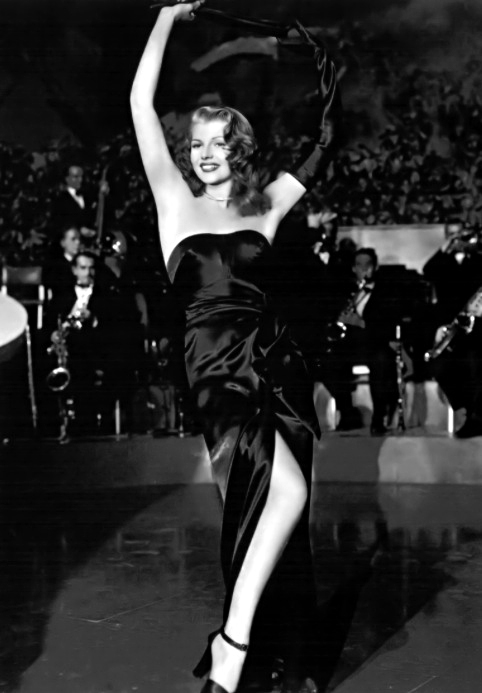 The girl born Margarita Carmen Cansino came to Hollywood as a professional dancer. Columbia Studios head Harry Cohn changed her name, insisted she lighten her hair color, and made her get electrolysis to raise her hairline and broaden the appearance of her forehead. She was a natural beauty, nonetheless.
The girl born Margarita Carmen Cansino came to Hollywood as a professional dancer. Columbia Studios head Harry Cohn changed her name, insisted she lighten her hair color, and made her get electrolysis to raise her hairline and broaden the appearance of her forehead. She was a natural beauty, nonetheless.
The prison film “The Shawshank Redemption” is based on Stephen King’s novella “Rita Hayworth and the Shawshank Redemption.” Fans of the movie will recall the scene where inmate Andy hangs a poster of Rita on the wall of his cell. If you have to spend eternity in a 4×6 concrete box, why not spend it with the Queen of the Pinup Girls while you plot your escape.
Happy birthday, Margarita Carmen Cansino, October 17, 1918 – May 14, 1987.
“Gilda” was directed by Charles Vidor and also starred Glenn Ford. The Library of Congress has preserved it in the United States National Film Registry as being “culturally, historically, or aesthetically significant.” While Rita doesn’t sing in this clip (it’s the voice of Anita Ellis), she does sing in her own voice and plays the guitar in the scene where she reprises “Put the Blame on Mame” while sitting at the casino bar. But man! Dig this classy dame!
© Dana Spiardi, Oct 17, 2015
]]>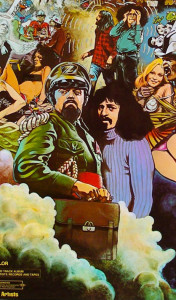 “Ladies and gentlemen, you can go mad on the road. That is precisely what this film is all about.” So goes the intro to Zappa’s “surrealistic documentary,” which opened at London’s Piccadilly Classic Cinema in the U.K. on this date in 1971. The film parodied the on-the-road touring experiences of his art-rock band, The Mothers of Invention. Ringo Starr played Larry the Dwarf (masquerading as Zappa), and Academy Award nominated actor and folk singer Theodore Bikel played Rance Muhammitz, a fascist dictator of sorts. The Who’s Keith Moon appeared as a pop star disguised as a groupie disguised as a nun. Need I go on?
“Ladies and gentlemen, you can go mad on the road. That is precisely what this film is all about.” So goes the intro to Zappa’s “surrealistic documentary,” which opened at London’s Piccadilly Classic Cinema in the U.K. on this date in 1971. The film parodied the on-the-road touring experiences of his art-rock band, The Mothers of Invention. Ringo Starr played Larry the Dwarf (masquerading as Zappa), and Academy Award nominated actor and folk singer Theodore Bikel played Rance Muhammitz, a fascist dictator of sorts. The Who’s Keith Moon appeared as a pop star disguised as a groupie disguised as a nun. Need I go on?
Die-hard Zappanistas and chemical connoisseurs no doubt found the film delightful. The casual viewer could make no sense of it. But, the movie was original and visually provocative enough to draw praise from two of America’s leading film critics. Since I can barely muster the words to describe the images and their impact on the psyche, I’ll leave it to the experts.
Vincent Canby of the New York Times wrote, “No self-proclaimed surrealistic documentary can be all bad when it has a score composed by Frank Zappa, the Orson Welles of the rock music world….It cheerily evokes the image of groupies, warm beer, cheeseburgers, overflowing ash trays, efficient plumbing and inefficient air-conditioning, which freezes the air without cleaning it, in an endless chain of identical bed-sitters that are the homes-away-from-home for the members of a touring rock group.” Wow, it sounds like Mr. Canby knows that setting a little too well.
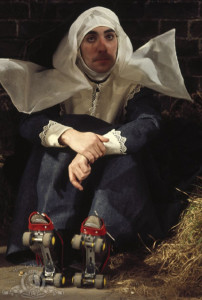 Roger Ebert of the Chicago Sun Times praises the technology behind the project: “We have been hearing for a long time that videotape is going to revolutionize filmmaking, and now here is the vanguard of the revolution. Whatever else it may be, Frank Zappa’s ‘200 Motels’ is a joyous, fanatic, slightly weird experiment in the uses of the color videotape process. If there is more that can be done with videotape, I do not want to be there when they do it…The movie is so unrelentingly high that you even wish for intermissions….It is the kind of movie you can barely see once: not because it’s simple, but became it’s so complicated that you finally realize you aren’t meant to get everything and sort everything out. It is a full wall of sight-and-sound input, and the experience of the input — not its content, is what Zappa’s giving us. ‘200 Motels’ is out of Howard Johnson by Tinker Bell, with Aquarius setting.” Hmmm, I wonder if the late, great Mr. Ebert was “unrelentingly high” when he screened the flick!
Roger Ebert of the Chicago Sun Times praises the technology behind the project: “We have been hearing for a long time that videotape is going to revolutionize filmmaking, and now here is the vanguard of the revolution. Whatever else it may be, Frank Zappa’s ‘200 Motels’ is a joyous, fanatic, slightly weird experiment in the uses of the color videotape process. If there is more that can be done with videotape, I do not want to be there when they do it…The movie is so unrelentingly high that you even wish for intermissions….It is the kind of movie you can barely see once: not because it’s simple, but became it’s so complicated that you finally realize you aren’t meant to get everything and sort everything out. It is a full wall of sight-and-sound input, and the experience of the input — not its content, is what Zappa’s giving us. ‘200 Motels’ is out of Howard Johnson by Tinker Bell, with Aquarius setting.” Hmmm, I wonder if the late, great Mr. Ebert was “unrelentingly high” when he screened the flick!
To borrow a line from Frank himself, watching “200 Motels” is “…a bit like eating a sausage: you don’t know what’s in it, you probably shouldn’t know what’s in there; but if it tastes good, well there you go.” And that’s a great philosophy to have when you’re out on the road looking for adventure. So, take a chance…save some dough on your next vacation and book a room in a minimalist dive. You’ll then be able to entertain your friends (or, like me, bore them to death) with your “motel from hell” stories for the next 20 years.
Now, sit back, grab whatever mind-altering substance you might have on hand, and enjoy the trailer:
© Dana Spiardi, Dec 16, 2013
]]>
 John’s fans may have been surprised to see him wearing glasses in this offbeat little film. Little did they know at the time that his vision had been poor since childhood. His Aunt Mimi constantly nagged him to wear his glasses – which, of course, he hated. Teddy Boys and Gene Vincent wanna-bes didn’t wear glasses! He stumbled around half-blind without specs until he finally began wearing contact lenses during the height of Beatlemania.
John’s fans may have been surprised to see him wearing glasses in this offbeat little film. Little did they know at the time that his vision had been poor since childhood. His Aunt Mimi constantly nagged him to wear his glasses – which, of course, he hated. Teddy Boys and Gene Vincent wanna-bes didn’t wear glasses! He stumbled around half-blind without specs until he finally began wearing contact lenses during the height of Beatlemania.
Imagine his dismay when he learned that his Private Gripweed role called for him to don the owlish wire-framed glasses once issued by Britain’s National Health system. Well, he ended up embracing his new look and wore the specs from that point on – thus creating a signature style that was quickly copied by the youth of the day. Nobody would have been caught dead wearing wire-rimmed granny glasses before John made them fashionable. I remember the day I went from plastic cat-eyes to wire rectangles. Sure, I loathed wearing glasses as a kid, but at least with cool Lennon frames I could feel more like the hippy-dippy flower child I longed to be. And then along came Janis Joplin with those huge round wire specs, to seal the style for chicks. Ah, kaleidoscope eyes behind those lenses.
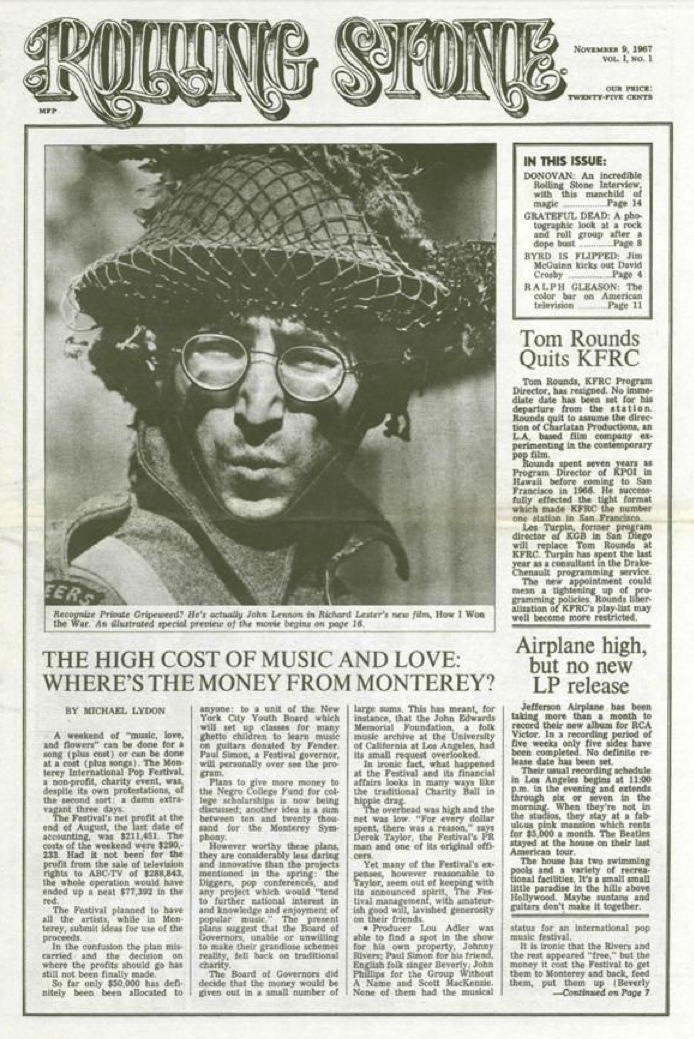 As for the movie? It was a critical and commercial disappointment. And what of John’s acting? Well, inspired, of course…but it really didn’t matter. The project gave him a break from the pressure of touring and recording with the Beatles. But, most importantly, a masterpiece emerged from the experience: during down-time on the set in Almeria, Spain, John composed what I consider his most magnificent song: “Strawberry Fields Forever.”
As for the movie? It was a critical and commercial disappointment. And what of John’s acting? Well, inspired, of course…but it really didn’t matter. The project gave him a break from the pressure of touring and recording with the Beatles. But, most importantly, a masterpiece emerged from the experience: during down-time on the set in Almeria, Spain, John composed what I consider his most magnificent song: “Strawberry Fields Forever.”
An iconic photo of bespectacled John in his combat helmet graced the cover of the very first issue of Rolling Stone magazine, on November 9, 1967 – several weeks after the film’s release.
Here’s a look at John’s scenes in “How I Won the War.”
© Dana Spiardi, October 9, 2014
]]>